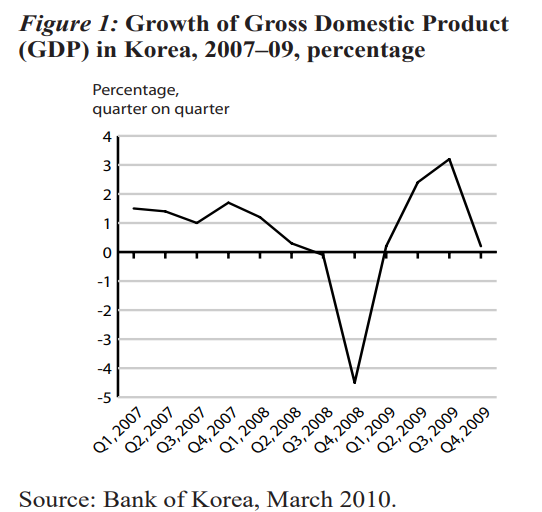How South Korea Revived the Economy through Green Spending in 2008
The 2008 financial crisis had dramatic impacts on the South Korean economy. In the final quarter of 2008, GDP declined by 4.5%, the second-largest contraction on record worldwide. The country suffered a capital deficit of USD 42.6 billion, equivalent to 20% of the GDP. The rate of employment growth fell below 1% during 2008-2009, with the growth in unemployment reaching a peak of 4% in March 2009.

The South Korea green stimulus package
In response, the government launched its green stimulus plan, touted as the ‘Green New Deal’ internationally, to help stimulate job creation and revive the economy. The package totalled USD 38.1 billion – about 4% of the GDP – to be implemented over 2009-2012. Of this, South Korea dedicated nearly 80% to green measures such as renewable energies (USD 1.80 billion), energy efficient buildings (USD 6.19 billion), low-carbon vehicles (USD 1.80 billion), railways (USD 7.01 billion), and water and waste management (USD 13.89 billion).
Fast implementation of these measures meant the country’s economy and the financial market began to stabilise during the first half of 2009. From December 2008 to January 2010, the Korean stock market index (KOSPI) increased by about 42.5%. Between 2008 and 2010, the government’s fiscal stimulus package included public spending and tax cuts, equivalent to 6.9% of the country’s GDP.
The Green Growth Five Year Plan
In July 2009, the government introduced the Green Growth Five Year Plan which aimed to invest 2% of the country’s GDP on green growth between 2009 and 2013. The plan focussed on nine key projects and 27 linked projects with an investment of KRW 50 trillion (USD 44 billion) up to 2012, intended to create 950,000 jobs. Additionally, the government introduced measures including the reduction of greenhouse gas emissions from businesses, the increase of its market share of renewable energy, and the introduction of an emissions trading scheme.
Green New Deal outcomes for South Korea
Despite its claims, South Korea’s Green New Deal attracted a lot of criticism. A study on the process and contents of South Korea’s green job policy found that, out of the Green New Deal budget of KWR 50 trillion, the largest share (KWR 15 trillion) was allocated to the controversial Four Major Rivers Restoration Project, as well as to the expansion of nuclear power plants. It also found that under the Korean classification of “green jobs”, it was impossible to distinguish among wind, solar PV, solar thermal power, nuclear power, and coal-fired power generation. Plus, green jobs in traditional environmental protection and pollution reduction received only limited support. As a result, the study argued that the government’s claim of 611,000 people employed in “green industries” in 2008 was likely an overestimate.
Another 2015 study also found the Green New Deal failed to deliver a green growth and emissions reduction. As a proportion of the country’s total employment, jobs in South Korea’s green industry only rose from 1.2% in 2008 to 2.2% in 2015. And despite the efforts towards a more sustainable power mix, the share of renewable sources in generation grew only 2.2% from 2006 to 2016 – well below the country’s 2030 goal of 11%.
There was also no significant reduction in coal dependence over this period. Coal dominated the electricity mix with a 41% share, whereas renewables only accounted for 4% in 2017. As a result, the CO2 emissions of South Korea increased by 35% from 2005 to 2018, accounting for 1.8% of global emissions in 2018.
Analysis of South Korea’s Green New Deal suggests the stimulus package was misunderstood by those outside the country. This was a result of the very attractive figures on the country’s growth, but local experts suggest the government’s policies on green growth focussed on the “growth” aspect whilst sacrificing the environment. Instead, it has been portrayed as “high carbon, gray growth”.
This article is part of the Green Stimulus as Response to COVID-19 Economy Impacts series, consisting of the in-depth introduction of the green stimulus packages and the different views on the effectiveness of the stimulus packages deployed in 2008-2009 in our series of case studies from the USA, China, and Europe.


